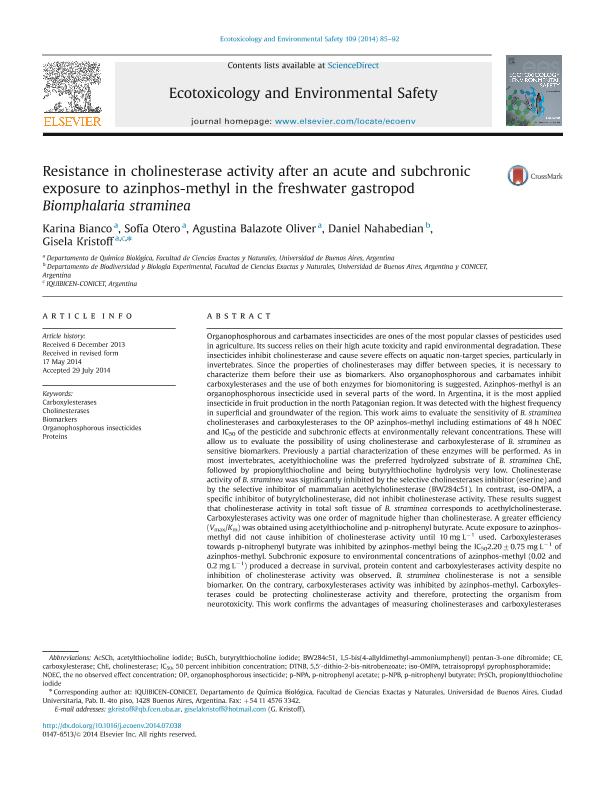Artículo
Resistance in cholinesterase activity after an acute and subchronic exposure to azinphos-methyl in the freshwater gastropod Biomphalaria straminea
Bianco, Karina; Otero, Sofía ; Balazote Oliver, Agustina
; Balazote Oliver, Agustina ; Nahabedian, Daniel Eduardo
; Nahabedian, Daniel Eduardo ; Kristoff, Gisela
; Kristoff, Gisela
 ; Balazote Oliver, Agustina
; Balazote Oliver, Agustina ; Nahabedian, Daniel Eduardo
; Nahabedian, Daniel Eduardo ; Kristoff, Gisela
; Kristoff, Gisela
Fecha de publicación:
08/2014
Editorial:
Elsevier Inc
Revista:
Ecotoxicology and Environmental Safety
ISSN:
0147-6513
Idioma:
Inglés
Tipo de recurso:
Artículo publicado
Clasificación temática:
Resumen
Organophosphorous and carbamates insecticides are ones of the most popular classes of pesticides used in agriculture. Its success relies on their high acute toxicity and rapid environmental degradation. These insecticides inhibit cholinesterase and cause severe effects on aquatic non-target species, particularly in invertebrates. Since the properties of cholinesterases may differ between species, it is necessary to characterize them before their use as biomarkers. Also organophosphorous and carbamates inhibit carboxylesterases and the use of both enzymes for biomonitoring is suggested. Azinphos-methyl is an organophosphorous insecticide used in several parts of the word. In Argentina, it is the most applied insecticide in fruit production in the north Patagonian region. It was detected with the highest frequency in superficial and groundwater of the region. This work aims to evaluate the sensitivity of B. straminea cholinesterases and carboxylesterases to the OP azinphos-methyl including estimations of 48 h NOEC and IC50 of the pesticide and subchronic effects at environmentally relevant concentrations. These will allow us to evaluate the possibility of using cholinesterase and carboxylesterase of B. straminea as sensitive biomarkers. Previously a partial characterization of these enzymes will be performed. As in most invertebrates, acetylthiocholine was the preferred hydrolyzed substrate of B. straminea ChE, followed by propionylthiocholine and being butyrylthiocholine hydrolysis very low. Cholinesterase activity of B. straminea was significantly inhibited by the selective cholinesterases inhibitor (eserine) and by the selective inhibitor of mammalian acethylcholinesterase (BW284c51). In contrast, iso-OMPA, a specific inhibitor of butyrylcholinesterase, did not inhibit cholinesterase activity. These results suggest that cholinesterase activity in total soft tissue of B. straminea corresponds to acethylcholinesterase. Carboxylesterases activity was one order of magnitude higher than cholinesterase. A greater efficiency (Vmax/Km) was obtained using acetylthiocholine and p-nitrophenyl butyrate. Acute exposure to azinphos-methyl did not cause inhibition of cholinesterase activity until 10 mg L−1 used. Carboxylesterases towards p-nitrophenyl butyrate was inhibited by azinphos-methyl being the IC502.20±0.75 mg L−1 of azinphos-methyl. Subchronic exposure to environmental concentrations of azinphos-methyl (0.02 and 0.2 mg L−1) produced a decrease in survival, protein content and carboxylesterases activity despite no inhibition of cholinesterase activity was observed. B. straminea cholinesterase is not a sensible biomarker. On the contrary, carboxylesterases activity was inhibited by azinphos-methyl. Carboxylesterases could be protecting cholinesterase activity and therefore, protecting the organism from neurotoxicity. This work confirms the advantages of measuring cholinesterases and carboxylesterases jointly in aquatic biomonitoring of pesticide contamination. This becomes relevant in order to find more sensitive biomarkers and new strategies to protect non-target aquatic organisms from pesticide contamination.
Archivos asociados
Licencia
Identificadores
Colecciones
Articulos(IBCN)
Articulos de INST.DE BIOLO.CEL.Y NEURCS."PROF.E.DE ROBERTIS"
Articulos de INST.DE BIOLO.CEL.Y NEURCS."PROF.E.DE ROBERTIS"
Articulos(OCA CIUDAD UNIVERSITARIA)
Articulos de OFICINA DE COORDINACION ADMINISTRATIVA CIUDAD UNIVERSITARIA
Articulos de OFICINA DE COORDINACION ADMINISTRATIVA CIUDAD UNIVERSITARIA
Citación
Bianco, Karina; Otero, Sofía; Balazote Oliver, Agustina; Nahabedian, Daniel Eduardo; Kristoff, Gisela; Resistance in cholinesterase activity after an acute and subchronic exposure to azinphos-methyl in the freshwater gastropod Biomphalaria straminea; Elsevier Inc; Ecotoxicology and Environmental Safety; 109; 8-2014; 85-92
Compartir
Altmétricas



